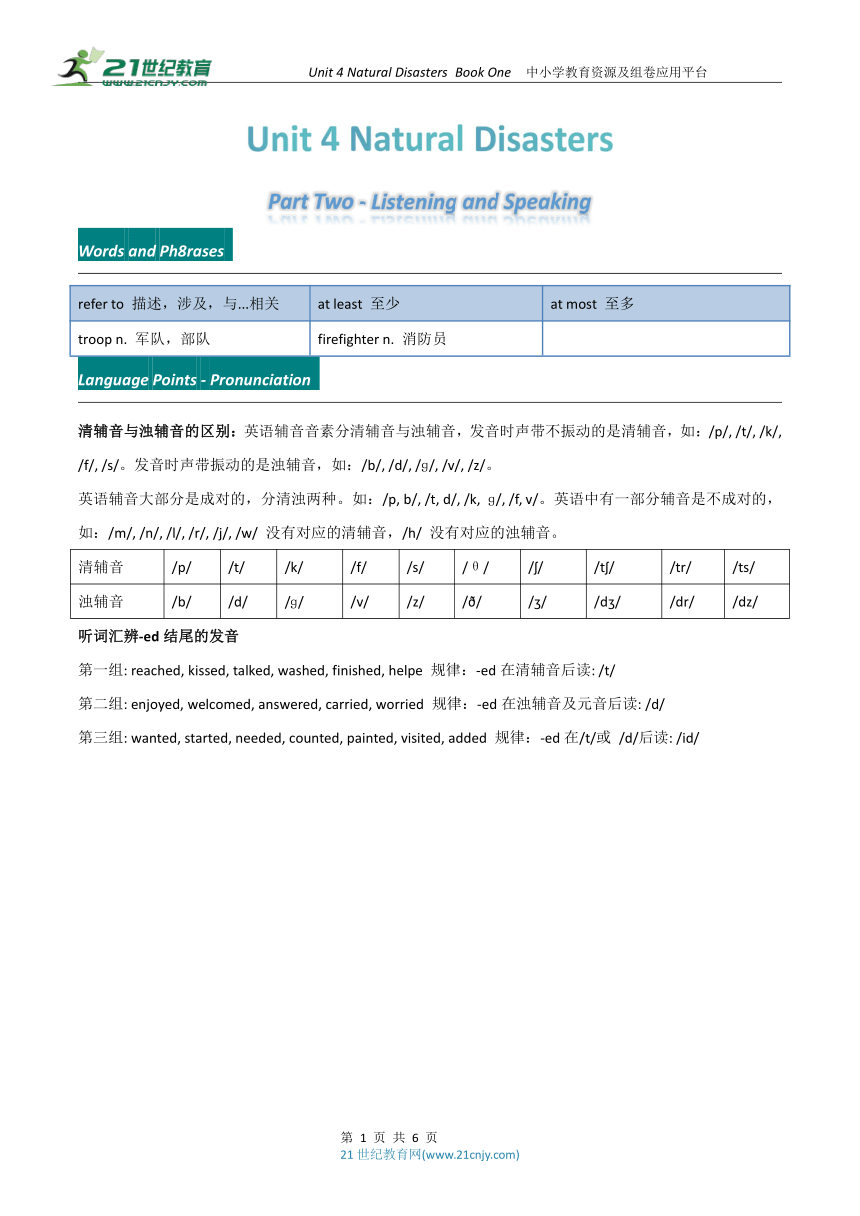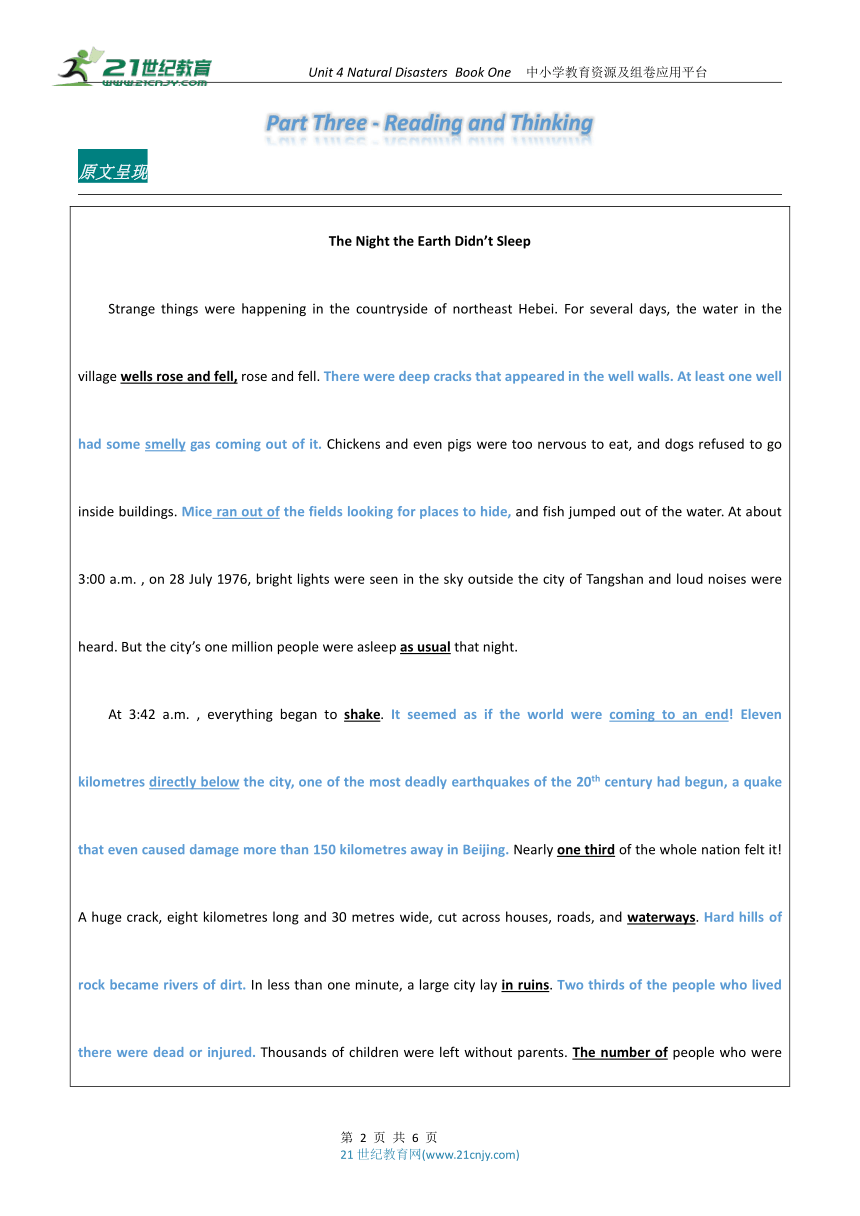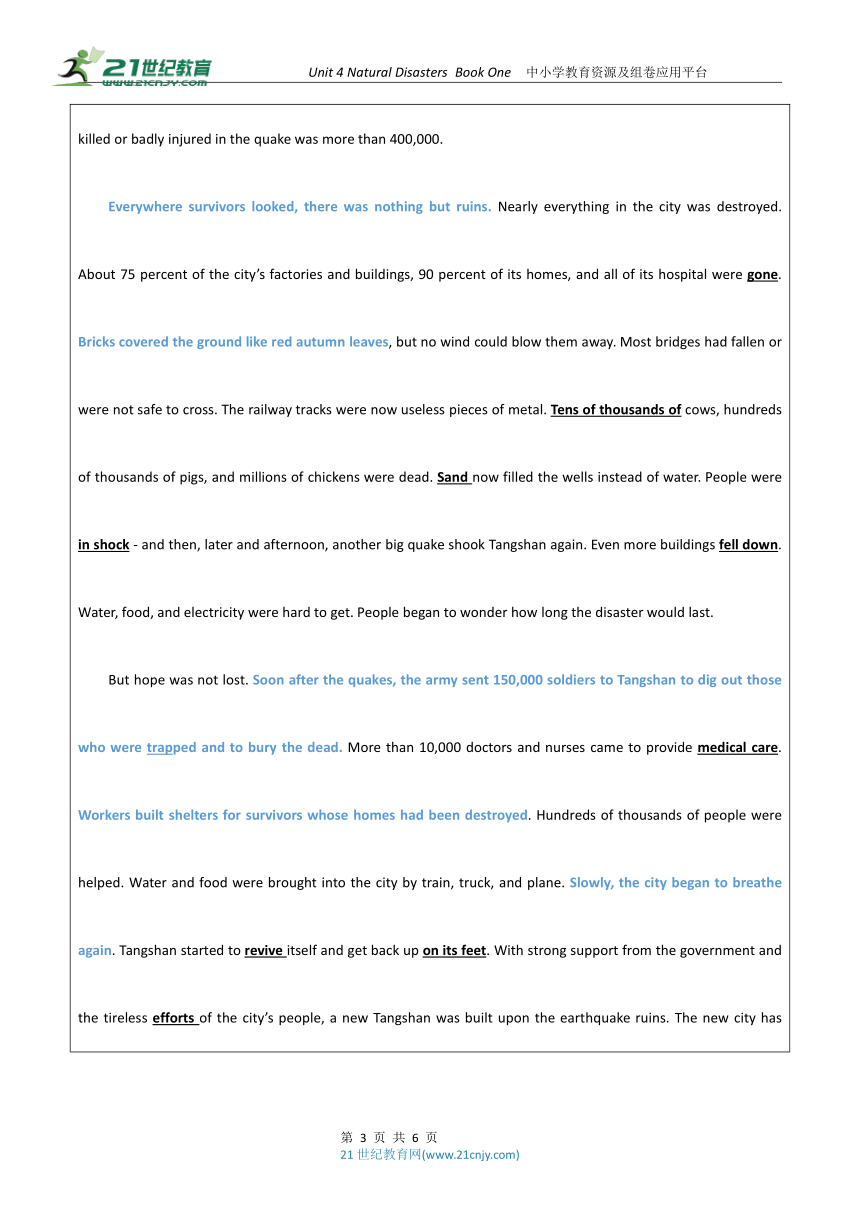Unit 4 Natural Disaters 讲义(含答案)Listening and Speaking& Reading and Thinking
文档属性
| 名称 | Unit 4 Natural Disaters 讲义(含答案)Listening and Speaking& Reading and Thinking |

|
|
| 格式 | docx | ||
| 文件大小 | 47.4KB | ||
| 资源类型 | 试卷 | ||
| 版本资源 | 人教版(2019) | ||
| 科目 | 英语 | ||
| 更新时间 | 2022-09-20 11:23:19 | ||
图片预览



文档简介
Unit 4 Natural Disasters
Part Two - Listening and Speaking
Words and Ph8rases
refer to 描述,涉及,与...相关 at least 至少 at most 至多
troop n. 军队,部队 firefighter n. 消防员
Language Points - Pronunciation
清辅音与浊辅音的区别:英语辅音音素分清辅音与浊辅音,发音时声带不振动的是清辅音,如:/p/, /t/, /k/, /f/, /s/。发音时声带振动的是浊辅音,如:/b/, /d/, /ɡ/, /v/, /z/。
英语辅音大部分是成对的,分清浊两种。如:/p, b/, /t, d/, /k, ɡ/, /f, v/。英语中有一部分辅音是不成对的,如:/m/, /n/, /l/, /r/, /j/, /w/ 没有对应的清辅音,/h/ 没有对应的浊辅音。
清辅音 /p/ /t/ /k/ /f/ /s/ /θ/ / / /t / /tr/ /ts/
浊辅音 /b/ /d/ /ɡ/ /v/ /z/ / / / / /d / /dr/ /dz/
听词汇辨-ed结尾的发音
第一组: reached, kissed, talked, washed, finished, helpe 规律:-ed在清辅音后读: /t/
第二组: enjoyed, welcomed, answered, carried, worried 规律:-ed在浊辅音及元音后读: /d/
第三组: wanted, started, needed, counted, painted, visited, added 规律:-ed在/t/或 /d/后读: /id/
Unit 4 Natural Disasters Book One 中小学教育资源及组卷应用平台
Part Three - Reading and Thinking
原文呈现
The Night the Earth Didn’t Sleep Strange things were happening in the countryside of northeast Hebei. For several days, the water in the village wells rose and fell, rose and fell. There were deep cracks that appeared in the well walls. At least one well had some smelly gas coming out of it. Chickens and even pigs were too nervous to eat, and dogs refused to go inside buildings. Mice ran out of the fields looking for places to hide, and fish jumped out of the water. At about 3:00 a.m. , on 28 July 1976, bright lights were seen in the sky outside the city of Tangshan and loud noises were heard. But the city’s one million people were asleep as usual that night. At 3:42 a.m. , everything began to shake. It seemed as if the world were coming to an end! Eleven kilometres directly below the city, one of the most deadly earthquakes of the 20th century had begun, a quake that even caused damage more than 150 kilometres away in Beijing. Nearly one third of the whole nation felt it! A huge crack, eight kilometres long and 30 metres wide, cut across houses, roads, and waterways. Hard hills of rock became rivers of dirt. In less than one minute, a large city lay in ruins. Two thirds of the people who lived there were dead or injured. Thousands of children were left without parents. The number of people who were killed or badly injured in the quake was more than 400,000. Everywhere survivors looked, there was nothing but ruins. Nearly everything in the city was destroyed. About 75 percent of the city’s factories and buildings, 90 percent of its homes, and all of its hospital were gone. Bricks covered the ground like red autumn leaves, but no wind could blow them away. Most bridges had fallen or were not safe to cross. The railway tracks were now useless pieces of metal. Tens of thousands of cows, hundreds of thousands of pigs, and millions of chickens were dead. Sand now filled the wells instead of water. People were in shock - and then, later and afternoon, another big quake shook Tangshan again. Even more buildings fell down. Water, food, and electricity were hard to get. People began to wonder how long the disaster would last. But hope was not lost. Soon after the quakes, the army sent 150,000 soldiers to Tangshan to dig out those who were trapped and to bury the dead. More than 10,000 doctors and nurses came to provide medical care. Workers built shelters for survivors whose homes had been destroyed. Hundreds of thousands of people were helped. Water and food were brought into the city by train, truck, and plane. Slowly, the city began to breathe again. Tangshan started to revive itself and get back up on its feet. With strong support from the government and the tireless efforts of the city’s people, a new Tangshan was built upon the earthquake ruins. The new city has become a home to more than seven million people, with great improvement in transportation. Tangshan city has proved to China and the rest of the world that in times of disaster, people must unify and show the wisdom to stay positive and rebuild for a brighter future.
Language Points
well adv. 好,对,完全,彻底 ... adj. 身体健康的 int. 好吧 ... n. 井,水井 vi. 涌出,冒出
rise and fall 起伏,升降 rise - rose -risen v. 上升,起床
smelly adj. 发出难闻气味的,难闻的 【词汇扩展】smell v. 闻起来 n. 气味
as usual 像往常一样
shake - shook - shaken v. 抖动,摇晃
come to an end 结束 【短语扩展】come to 达到,进入(状态或境地),作出(决定),达成(协议)
directly below 正下方
one third 三分之一 ·分数的表达,分子用基数词,分母用序数词,当分子大于时,分母加-s
waterway cn. 水路,航道 【词汇扩展】land route 陆路 air route 航线
in ruins 严重受损,破败不堪 ·ruin un./vt. 破坏,毁坏
the number of “...的数量”。作主语视为单数 a number of 大量,许多;作主语视为复数
gone adj. 不复存在,用完了,(人)离开了
tens of thousand of 成千上万,千万万万,千百万
sand n. 沙滩,沙 v. 用砂纸打磨
in shock 震惊,吃惊 ·shock n. 震惊,令人震惊的事,休克 v. (使)震惊
fall down 倒塌,跌倒 fall over 跌倒
trap -trapped - trapped v. 使落入陷阱,使陷入圈套 cn. 陷阱,险境
medical care 医疗护理
revive v. 复活,苏醒
on one’s feet (困境后)恢复,完全复原,(病后)痊愈
effort n. 努力,尽力,努力的尝试
became/be a home to... 是...的家乡/家园
prove v. 正实,证明,后来被发现是,最终显现为
in times of 在..的时候 at times 有时
wisdom n. 智慧,才智 【词汇扩展】wise adj. 明智的
rebuild - rebuilt - rebuilt v. 重建,重组,重新分配
Sentences
There were deep cracks that appeared in the well walls.
that 引导__________,在从句中做__________,修饰先行词__________,
At least one well had some smelly gas coming out of it.
现在分词短语做__________,修饰__________,与__________在逻辑上是_____关系
Mice ran out of the fields looking for places to hide...
现在分词做__________,mice 和 look for 是__________关系
It seemed as if the world were coming to an end!
It seemed as if ... “看起来好像...”as if 引导__________从句
... one of the most deadly earthquakes of the 20th century had begun, a quake that even caused damage more than 150 kilometres away in Beijing.
a quake ... in Beijing 做 one ... earthquakes 的同位语,其中that引导______, 在从句中作____修饰_____
Hard hills of rock became rivers of dirt. 本句使用了隐喻(metaphor)的修辞手法,将泥石流比喻成河流
隐喻:将被描写的事物比喻成相似的事物,但不在句子中使用like, as等表示“像”的词语
Two thirds of the people who lived there were dead or injured.
who 引导_________, 在从句中作_______, 修饰_______
Everywhere survivors looked, there was nothing but ruins.
everywhere 作地点连词,引导________; there was/is nothing but ... “除了...之外,什么都没有/一无所有”
Bricks covered the ground like red autumn leaves... 本句使用了明喻 (simile) 的修辞手法
明喻:将被描写的事物比喻成相似的事物,但和隐喻不同,在句子中需要使用like, as等表示“像”的词语
Soon after the quakes, the army sent 150,000 soldiers to Tangshan to dig out those who were trapped and to bury the dead.
to do 不定式做__________, who 引导__________
Workers built shelters for survivors whose homes had been destroyed
whose引导_________, 在从句中做_________, 修饰___________
Slowly, the city began to breathe again. 本句使用了拟人(personification) 的修辞手法,把事物人格化,将事物变成人一样,会做出动作或拥有感情
Tangshan city has proved to China and the rest of the world that in times of disaster, people must unify and show the wisdom to stay positive and rebuild for a brighter future.
that 引导_________, 在从句中做_________
part 3 答案
定语从句,主语,cracks
后置定语;gas; gas;主谓
伴随状语,mice 与look;主谓关系
表语从句
定语从句;主语;quake
定语从句;主语,people
连词;地点状语从句
目的状语;定语从句
定语从句,定语;survivors
宾语从句;不做成分
Part Two - Listening and Speaking
Words and Ph8rases
refer to 描述,涉及,与...相关 at least 至少 at most 至多
troop n. 军队,部队 firefighter n. 消防员
Language Points - Pronunciation
清辅音与浊辅音的区别:英语辅音音素分清辅音与浊辅音,发音时声带不振动的是清辅音,如:/p/, /t/, /k/, /f/, /s/。发音时声带振动的是浊辅音,如:/b/, /d/, /ɡ/, /v/, /z/。
英语辅音大部分是成对的,分清浊两种。如:/p, b/, /t, d/, /k, ɡ/, /f, v/。英语中有一部分辅音是不成对的,如:/m/, /n/, /l/, /r/, /j/, /w/ 没有对应的清辅音,/h/ 没有对应的浊辅音。
清辅音 /p/ /t/ /k/ /f/ /s/ /θ/ / / /t / /tr/ /ts/
浊辅音 /b/ /d/ /ɡ/ /v/ /z/ / / / / /d / /dr/ /dz/
听词汇辨-ed结尾的发音
第一组: reached, kissed, talked, washed, finished, helpe 规律:-ed在清辅音后读: /t/
第二组: enjoyed, welcomed, answered, carried, worried 规律:-ed在浊辅音及元音后读: /d/
第三组: wanted, started, needed, counted, painted, visited, added 规律:-ed在/t/或 /d/后读: /id/
Unit 4 Natural Disasters Book One 中小学教育资源及组卷应用平台
Part Three - Reading and Thinking
原文呈现
The Night the Earth Didn’t Sleep Strange things were happening in the countryside of northeast Hebei. For several days, the water in the village wells rose and fell, rose and fell. There were deep cracks that appeared in the well walls. At least one well had some smelly gas coming out of it. Chickens and even pigs were too nervous to eat, and dogs refused to go inside buildings. Mice ran out of the fields looking for places to hide, and fish jumped out of the water. At about 3:00 a.m. , on 28 July 1976, bright lights were seen in the sky outside the city of Tangshan and loud noises were heard. But the city’s one million people were asleep as usual that night. At 3:42 a.m. , everything began to shake. It seemed as if the world were coming to an end! Eleven kilometres directly below the city, one of the most deadly earthquakes of the 20th century had begun, a quake that even caused damage more than 150 kilometres away in Beijing. Nearly one third of the whole nation felt it! A huge crack, eight kilometres long and 30 metres wide, cut across houses, roads, and waterways. Hard hills of rock became rivers of dirt. In less than one minute, a large city lay in ruins. Two thirds of the people who lived there were dead or injured. Thousands of children were left without parents. The number of people who were killed or badly injured in the quake was more than 400,000. Everywhere survivors looked, there was nothing but ruins. Nearly everything in the city was destroyed. About 75 percent of the city’s factories and buildings, 90 percent of its homes, and all of its hospital were gone. Bricks covered the ground like red autumn leaves, but no wind could blow them away. Most bridges had fallen or were not safe to cross. The railway tracks were now useless pieces of metal. Tens of thousands of cows, hundreds of thousands of pigs, and millions of chickens were dead. Sand now filled the wells instead of water. People were in shock - and then, later and afternoon, another big quake shook Tangshan again. Even more buildings fell down. Water, food, and electricity were hard to get. People began to wonder how long the disaster would last. But hope was not lost. Soon after the quakes, the army sent 150,000 soldiers to Tangshan to dig out those who were trapped and to bury the dead. More than 10,000 doctors and nurses came to provide medical care. Workers built shelters for survivors whose homes had been destroyed. Hundreds of thousands of people were helped. Water and food were brought into the city by train, truck, and plane. Slowly, the city began to breathe again. Tangshan started to revive itself and get back up on its feet. With strong support from the government and the tireless efforts of the city’s people, a new Tangshan was built upon the earthquake ruins. The new city has become a home to more than seven million people, with great improvement in transportation. Tangshan city has proved to China and the rest of the world that in times of disaster, people must unify and show the wisdom to stay positive and rebuild for a brighter future.
Language Points
well adv. 好,对,完全,彻底 ... adj. 身体健康的 int. 好吧 ... n. 井,水井 vi. 涌出,冒出
rise and fall 起伏,升降 rise - rose -risen v. 上升,起床
smelly adj. 发出难闻气味的,难闻的 【词汇扩展】smell v. 闻起来 n. 气味
as usual 像往常一样
shake - shook - shaken v. 抖动,摇晃
come to an end 结束 【短语扩展】come to 达到,进入(状态或境地),作出(决定),达成(协议)
directly below 正下方
one third 三分之一 ·分数的表达,分子用基数词,分母用序数词,当分子大于时,分母加-s
waterway cn. 水路,航道 【词汇扩展】land route 陆路 air route 航线
in ruins 严重受损,破败不堪 ·ruin un./vt. 破坏,毁坏
the number of “...的数量”。作主语视为单数 a number of 大量,许多;作主语视为复数
gone adj. 不复存在,用完了,(人)离开了
tens of thousand of 成千上万,千万万万,千百万
sand n. 沙滩,沙 v. 用砂纸打磨
in shock 震惊,吃惊 ·shock n. 震惊,令人震惊的事,休克 v. (使)震惊
fall down 倒塌,跌倒 fall over 跌倒
trap -trapped - trapped v. 使落入陷阱,使陷入圈套 cn. 陷阱,险境
medical care 医疗护理
revive v. 复活,苏醒
on one’s feet (困境后)恢复,完全复原,(病后)痊愈
effort n. 努力,尽力,努力的尝试
became/be a home to... 是...的家乡/家园
prove v. 正实,证明,后来被发现是,最终显现为
in times of 在..的时候 at times 有时
wisdom n. 智慧,才智 【词汇扩展】wise adj. 明智的
rebuild - rebuilt - rebuilt v. 重建,重组,重新分配
Sentences
There were deep cracks that appeared in the well walls.
that 引导__________,在从句中做__________,修饰先行词__________,
At least one well had some smelly gas coming out of it.
现在分词短语做__________,修饰__________,与__________在逻辑上是_____关系
Mice ran out of the fields looking for places to hide...
现在分词做__________,mice 和 look for 是__________关系
It seemed as if the world were coming to an end!
It seemed as if ... “看起来好像...”as if 引导__________从句
... one of the most deadly earthquakes of the 20th century had begun, a quake that even caused damage more than 150 kilometres away in Beijing.
a quake ... in Beijing 做 one ... earthquakes 的同位语,其中that引导______, 在从句中作____修饰_____
Hard hills of rock became rivers of dirt. 本句使用了隐喻(metaphor)的修辞手法,将泥石流比喻成河流
隐喻:将被描写的事物比喻成相似的事物,但不在句子中使用like, as等表示“像”的词语
Two thirds of the people who lived there were dead or injured.
who 引导_________, 在从句中作_______, 修饰_______
Everywhere survivors looked, there was nothing but ruins.
everywhere 作地点连词,引导________; there was/is nothing but ... “除了...之外,什么都没有/一无所有”
Bricks covered the ground like red autumn leaves... 本句使用了明喻 (simile) 的修辞手法
明喻:将被描写的事物比喻成相似的事物,但和隐喻不同,在句子中需要使用like, as等表示“像”的词语
Soon after the quakes, the army sent 150,000 soldiers to Tangshan to dig out those who were trapped and to bury the dead.
to do 不定式做__________, who 引导__________
Workers built shelters for survivors whose homes had been destroyed
whose引导_________, 在从句中做_________, 修饰___________
Slowly, the city began to breathe again. 本句使用了拟人(personification) 的修辞手法,把事物人格化,将事物变成人一样,会做出动作或拥有感情
Tangshan city has proved to China and the rest of the world that in times of disaster, people must unify and show the wisdom to stay positive and rebuild for a brighter future.
that 引导_________, 在从句中做_________
part 3 答案
定语从句,主语,cracks
后置定语;gas; gas;主谓
伴随状语,mice 与look;主谓关系
表语从句
定语从句;主语;quake
定语从句;主语,people
连词;地点状语从句
目的状语;定语从句
定语从句,定语;survivors
宾语从句;不做成分
